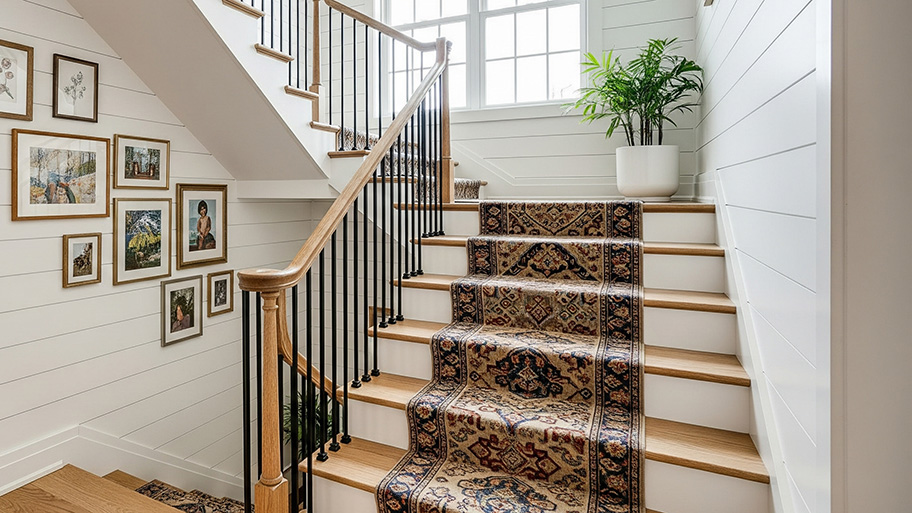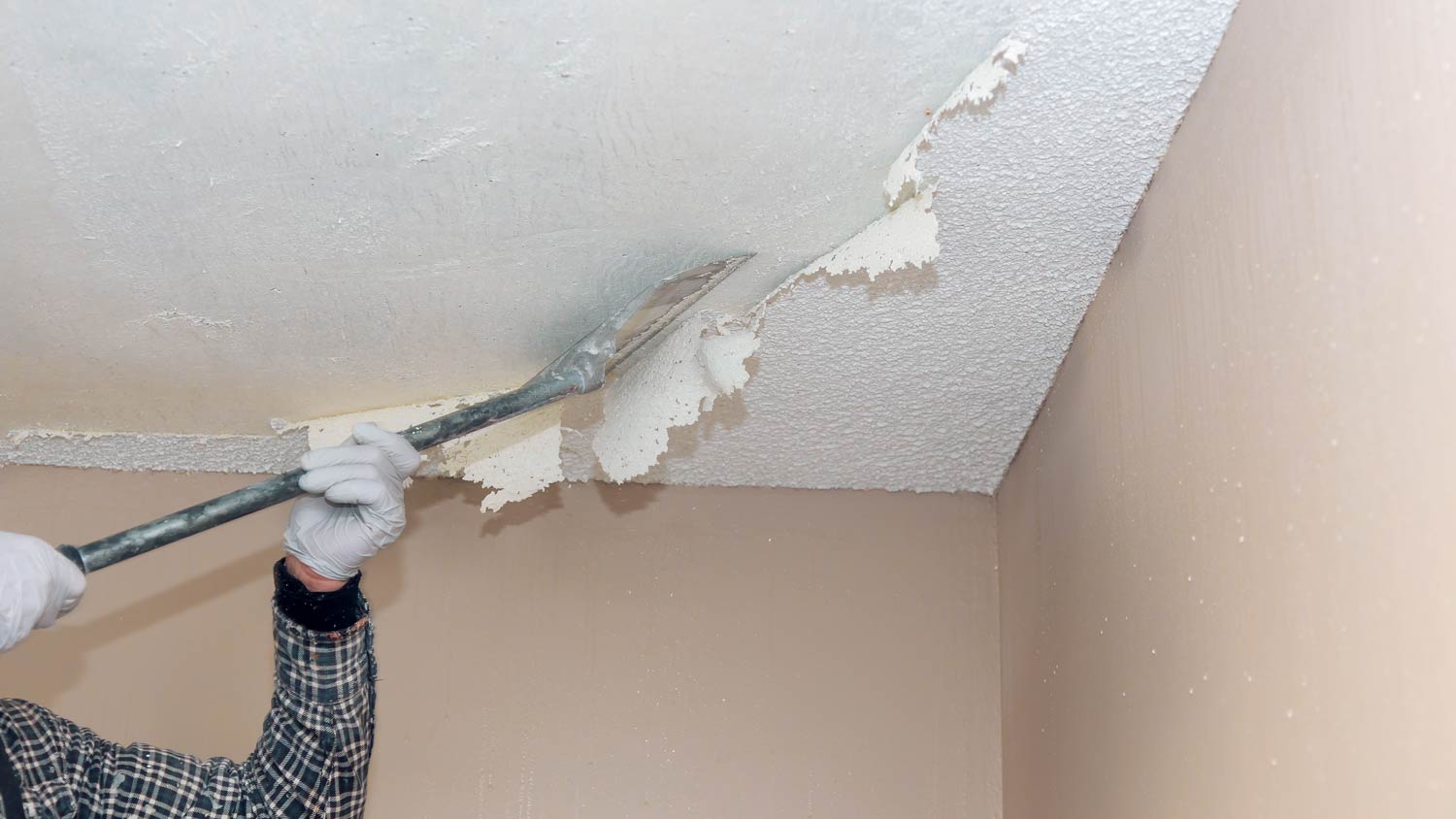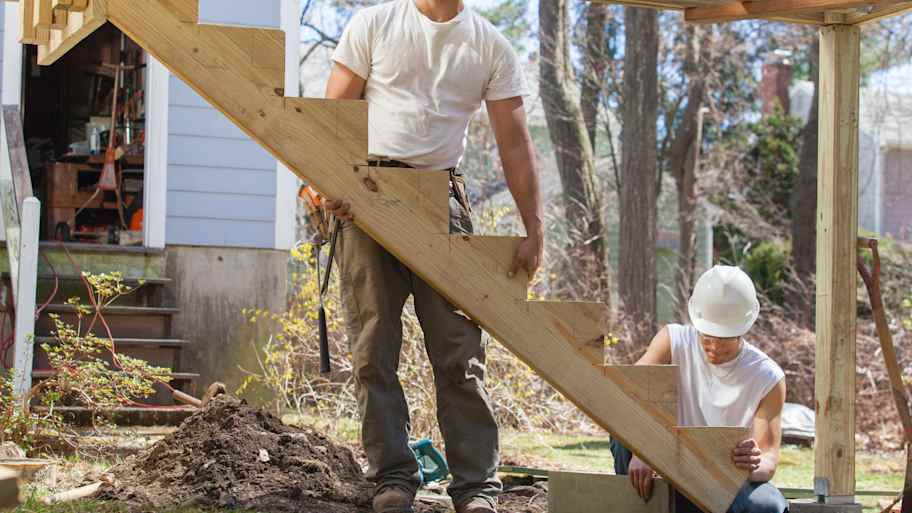
Discover stair repair cost estimates, including average prices, key cost factors, and tips to help you budget for your stair repair project.
Dated trend or useful feature? Popcorn ceilings can be divisive


Popcorn ceilings are named after their rough surface texture that resembles smashed-up corn kernels.
Popcorn ceilings were initially installed in homes because they’re easier to install than drywall ceilings.
Popcorn ceilings can help soundproof and waterproof a room, but they are difficult to repair or clean.
Some popcorn ceilings in older homes may contain asbestos, so it’s best to hire a pro to remove them.
Removing a popcorn ceiling costs anywhere from $900 to $3,000.
What is a “popcorn” ceiling? They were once a ubiquitous trend, but many people today want them removed. Not only are popcorn ceilings a bit outdated, but they also can harbor asbestos. So, if you are planning to scrape that texture off, it is important to test for possible dangers before moving forward with any projects.
Popcorn ceilings got their name because they look like smashed-up popcorn kernels tacked onto the ceiling. Also referred to as stipple ceilings, stucco ceilings, textured ceilings, acoustic ceilings, and cottage cheese ceilings, popcorn ceilings were popular up until the end of the ‘90s for their easy and low-cost installation process.
Made from sprayed-on paint and acoustic materials like Styrofoam beads, popcorn ceilings' bumpy texture helps deaden a room's noise and cover any potential cracks or water spots. But as styles changed (and industry standards improved), most homeowners chose to hire a company to remove popcorn ceilings.
When popcorn ceilings were popular (roughly from 1945 to the 1990s), they acted as a quick spray-on solution that covered flaws in one swoop. If you have ever finished a drywall ceiling, or if you are familiar with how it is done, you will know that it is not an easy process. There are many layers of taping and mudding that can be difficult to master without flaws. Adding the extra texture was an easy way of covering these up.
Nowadays, professional local ceiling contractors take care to ensure a smooth, flawless finish that needs no cover-up. The dated popcorn ceiling is now a feature that most homeowners wish to get rid of, especially before putting a home up for sale.
| Pros | Cons |
|---|---|
| Cost-effective finish | Outdated look and feel |
| Improves room acoustics | Hard to repair |
| Hides cracks and imperfections | Difficult to clean |
The texture of a popcorn ceiling does a lot to conceal imperfections in the ceiling, without the need for extensive drywall finishing.
Also on the plus side, the textured surface helps to block sound. You may appreciate having a popcorn ceiling if you live in a house with neighbors above you or if you want some sound insulation between the floors of your own home. While the textured surface can make a ceiling feel lower, it does reduce echoing.
These ceilings were even known for their fire-retardant capabilities, since a primary ingredient in a popcorn ceiling is often vermiculite, which is fire-resistant.
If you are in a home built before the 1980s, there is a chance that your popcorn ceiling might contain asbestos. This once-popular building material was often used for popcorn ceilings before it became banned as a hazardous substance in 1978. Unfortunately, many older homes still have it, especially wherever there is a popcorn ceiling.
If your home was built before the 1970s, there’s a chance some of the building materials used contain asbestos. You'll need to hire a pro to detect for any asbestos.
This does not mean you need to rush and scrape off your ceiling as quickly as possible. In fact, until you have had it tested by a local asbestos testing contractor, it is extremely important to leave it as is. Even if there is asbestos, you should be safe if there is no crumbling or structural damage that could release the particles into the air.
Even without the asbestos risks, there may be other reasons to ditch the popcorn ceiling. Aesthetically, popcorn ceilings may not be everyone's cup of tea. Since the look is considered dated these days, having textured ceilings may reduce your home's value. The texture of a popcorn ceiling can also make it challenging to clean. All those nooks and crannies can be a magnet for dust.
Removing a popcorn ceiling typically increases your home value, for two reasons. First, it gets rid of a feature that may contain asbestos, putting buyers' minds at ease. Second, it eliminates a feature that may not be appealing to the majority of buyers today.
While you are likely to see a bit more competition for your home minus the popcorn ceilings, do not expect a dramatic increase in the overall value. You are likely to recoup the cost of hiring a local popcorn ceiling removal company, but not much else. That being said, having an updated look is priceless to some homeowners.

Popcorn ceiling removal costs anywhere between $900 and $3,000. Prices depend on variables such as ceiling height and the overall complexity of the project. Dealing with asbestos calls for an asbestos abatement contractor near you, as removal could release dangerous debris into your home.
You can also remove a popcorn ceiling yourself if you do not mind a messy project. Once you have determined that the ceiling does not contain asbestos, removal is pretty simple. For unpainted popcorn ceilings, spray it down with water and scrape it away with a putty knife. Painted ceilings will require a stripping product. A local ceiling repair contractor can help you with any hidden flaws you uncover.
If you want to hire a pro, a local popcorn ceiling removal contractor is your best bet. Or, if you are not able to get rid of it just yet, there is nothing wrong with embracing the retro vibe. At the very least, adding some dim, ambient lighting can make the texture a lot less noticeable.
Great customer service. Was very professional during the whole process. Would like to work with the business again.
All I can say is they were WONDERFUL from start to finish.I dealt mostly with the owner Joe Frederico and he was polite,honest,and highly professional. He even dropped the car off at my house when he was finished as an extra courtesy.This business comes HIGHLY recommended.A+++++++++++++++++++++
As an out-of-state owner, it can be difficult to arrange visits for new vendors and come to an understanding about project scope. Mr. Milligan was candid and easy to communicate with as he assessed and reported on the work tasks. He was honest in his own comfort level and capabilities,...
He is extremely punctual and he wanted me to go through the whole thing. He was very impressive. His quote was reasonable priced. He is very knowledgable. I had three quotes and he is the guy whom I trusted the most and who I thought had the most knowledge. And I think he is a really good guy...
They did a good job and I will give them A's across the board.They were here anticipated and got the job done in an hour.
Gary Gasparini, the landscaper from Gasparini Landscaping Co. maintains my hundred year old yard and keeps it all appropriate. I have never needed to add any new landscaping. I like him a lot. He keeps it neat, clean and under control. I would continue to use his services in the future.
Previous experiences with painters have either been long-drawn out affairs or very uneven work. They worked with me on the start date so that we could sand our porch decks for a better outcome. Steve Byrnes uses a foreman who directs all the painters, who all are experienced workers who...
From average costs to expert advice, get all the answers you need to get your job done.

Discover stair repair cost estimates, including average prices, key cost factors, and tips to help you budget for your stair repair project.

Strong floor joists are the key to a structurally safe home. The cost of floor joist repair will often come down to what is causing the problem.

Brick walls can add character and elegance to interior and exterior spaces. Use this brick wall cost guide to see the price range for adding one to your home.

Stair stringers support every step you take. From wood to steel, open to closed—explore the different types, materials, and whether to DIY or hire a pro.

Curious about how to frame a house like a professional? While it's rarely a DIY job, understanding the process can prepare you for your upcoming home construction.

To create a comfortable indoor environment, learn how to soundproof a ceiling. We’ll break down the different ways to get it done.